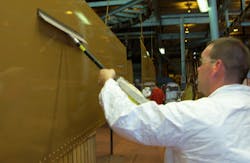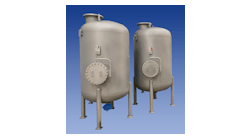A steel storage tank’s coating is only as good as its application
The most carefully considered decision made when buying a steel storage tank should be the one that determines the quality of its coating. Other factors — including size, capacity, cost, turnaround time and ease of construction — are impacted by the coating decision.
In addition, special features specific to the application and location might be needed, and maintenance requirements and storage vessel life cycle should be considered in your deliberations. But the quality of the tank’s coating is paramount. Its coating is the only defense the tank has against corrosion.Because unwanted corrosion can contaminate liquids, it’s important to ask suppliers questions that allow the confident choice of a coating with proven field performance. Moreover, how the coating is applied further separates the quality of one tank from another. Coating application will take place either at the factory or in the field.
Surface preparation
Uncoated steel forms a thin corrosion layer as soon as the raw sheets are laid out. Tank manufacturers should remove this layer prior to coating application. Some manufacturers prepare the surface with chemicals to prepare the surface, which is cost effective, but of limited efficacy.
A more vigorous surface preparation, such as blasting with grit, not only removes surface corrosion but also roughens the steel surface so a coating can better grip or adhere to it. A proper sandblast procedure yielding the maximum cleaning and surface profile should meet standards such as "NACE No. 2/SSPC-SP 10 Near White Cleanliness" to ensure the coating adheres properly.
Once the surface is prepared, because of its vulnerability to environmental contamination, the clock is ticking. Flash rust can occur in as little as 30 minute’s time. This aspect of the coating process is often overlooked, yet it’s critical to avoid compromising the coating’s quality. The length of time between surface preparation and paint application affects the expected field longevity. Some users specify a first coating be applied less than 15 minutes after the surface preparation is complete.
Airborne particles, as environmental contamination, can negatively impact coating surface adhesion. Tank manufacturers employ significant quality control measures, including cleaning and filtering equipment, to prevent air particulates from interfering with coating adhesion.
Factory-coated tanks will undergo surface preparation as part of their application process. Tanks that receive field coatings should be inspected to ensure good preparation on all surfaces, including the underside of the floor, which is not easy to reach, as well as on the underside of roofs, which requires blasting shot upward. Good surface preparation includes uniform grit blast coverage even in hard-to-reach spots and achieving a uniform mill profile for maximum coating adhesion.
Testing applied coatings
Throughout a factory-applied coating process, incremental tests ensure that it advances without compromise. Wash water temperature and pH, proper grit blast profile, paint booth temperature, humidity and air quality are all potential test parameters.
Applied to individual tank panels under environmentally controlled conditions, coatings are closely monitored throughout the process. Two common factory-applied coatings are high quality glass-fused-to-steel (porcelain enamel) and powdered epoxy.
High-tech coating lines control the process by measuring coating quality and thickness, capturing overspray, monitoring air particulates and testing for uniformity. Glass-fused-to-steel coatings are applied in layers of two to three coats, including a top coat. Powdered epoxy coatings are applied electrostatically to ensure uniform thickness and good adhesion to corners and edges.
Some epoxy-coated tanks have a coat on the tank exterior in lieu of a top coat of acrylic polyurethane. However, acrylic polyurethane offers better UV resistance, which results in less chalking and fading.
Factory application
Fusing glass to steel requires molecular interaction, resulting in a coating that blends glass and steel so that one cannot be separated from the other. The fusing takes place at the steel surface at 1500 F, forming a tight chemical comingling of materials. Glass frit cannot be fused to a substrate in the field, therefore glass-fused-to-steel coatings are only factory applied.
Some glass-fused-to-steel tank manufacturers fire the panels after two coat applications, then follow with a third coat and second firing. The most advanced tank manufacturers have technology that fuses three coats to the steel during one firing. This reduces the cost and time required for the coating application, as well as the risk of contamination between coats.
How the curing proceeds varies from tank to tank. Factory-applied epoxy coatings sometimes are cured by ambient air; however, a thermal cure is preferred. Thermal curing takes panels through ovens at temperatures up to of 400 F.
Epoxy coatings applied and cured under factory-controlled conditions are proven to be durable and long lasting. But beware of tank vendors who claim their epoxy is "fused" to steel, as this is technically impossible.
Field work
In the field, tanks often are sand blasted and coated with epoxy, using a hand-held sprayer. Some localities require sand blasting and that paint overspray be captured by tenting, to prohibit silica or VOC release into the atmosphere.
Field installation often includes applying two coats, typically a primer followed by a top coat of such as acrylic polyurethane. It is possible, although difficult, to monitor and control air particulates during field-coating application. Contamination is a concern, as curing is subject to local ambient conditions such as air temperature and humidity.
Field applied coatings most commonly rely on ambient air to cure, which can take up to 72 hours. The ambient air curing process is subject to weather and environmental conditions, including temperature, humidity, wind and dust.
All tank coatings should be tested for quality. Missed spots often are not detectable by the human eye. Rust and corrosion will start at a pin point-sized missed spot — or "holiday" — and spread. While corrosion creep will not occur with glass-fused-to-steel coatings, all coatings — including glass — must be holiday tested for missed spots prior to the tank’s first use.
Test time
The basic test for holidays uses a 12-volt tester. A wet sponge with an electrical charge is moved across the surface. The metal behind the coating also receives a charge. Wherever the wet sponge touches bare metal, a circuit is completed and the holiday is made known by either an audible or visual indicator.
A more stringent test, however, is the high-voltage spark detector. This test uses the material’s dielectric strength to determine the minimal coating thickness. Both a wand and the tank wall receive a charge. If the electrical current reaches bare metal or detects thinly applied coating, a spark appears, showing the exact location. High-voltage defect testing validates coating uniformity across surfaces, including tough-to-reach areas. Thinly applied coating may allow premature corrosion. High-voltage defect testing is not common among tank manufacturers, and its use is another way to measure tank-coating quality.
For field applications, both tests may be employed. However, a high voltage spark detector test should be requested. When coating with a hand-held sprayer, it’s difficult to ensure uniform surface application. Outside the factory setting, the best scenario includes hiring an independent certified coatings inspector to monitor the coating-application process, ensuring proper tenting, surface preparation, checking mill thickness and other parameters.
Many coatings manufacturers recommend using an NSF-certified inspector. It may be tempting to inspect coatings yourself, but a trained expert certifies that coating is properly applied, ensuring the longest possible life for your tank.
Final words
Your tank is only as strong as its coating. The better the application process, the longer the tank will last. While it’s tempting to choose a tank based solely on up-front cost, do your research based on total life cycle cost.
A field-applied coating may require repainting sooner than a factory-applied coating. Ask vendors to explain their coating process. Ask for data and case histories about how coating performs over time. Ask about maintenance and recoating requirements. Finally, investigate quality control and testing measures used.
While most tank manufacturers claim to have the "best" coating, this can only be proven through years of performance. Therefore, audit or visit the factory where your coating will be applied, or visit a site where a tank is receiving a field-applied coating, to validate the steps taken during the coating application process and ensure your tank manufacturer delivers a solution for long-lasting, durable storage.
Mark Eklund P.E. serves as materials specialist for CST Storage. With more than 35 years of experience serving the wastewater treatment market, Mark provides design leadership and solutions management for CST Storage. Mark earned a BS degree in civil engineering with an environmental emphasis from the University of Wisconsin. Contact: [email protected] or 913-621-3700.
CST Storage specializes in the manufacture and erection of complete storage systems — enamel and epoxy coated bolted tank designs, domes and covers, integrated reclaiming systems and more for liquid and dry bulk storage worldwide. CST Storage tanks and covers are manufactured at ISO 9001 Certified facilities and are found in 125 countries worldwide.



